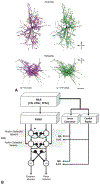Sensorimotor anatomy of gait, balance, and falls
- PMID: 30482322
- PMCID: PMC7069605
- DOI: 10.1016/B978-0-444-63916-5.00001-X
Sensorimotor anatomy of gait, balance, and falls
Abstract
The review demonstrates that control of posture and locomotion is provided by systems across the caudal-to-rostral extent of the neuraxis. A common feature of the neuroanatomic organization of the postural and locomotor control systems is the presence of key nodes for convergent input of multisensory feedback in conjunction with efferent copies of the motor command. These nodes include the vestibular and reticular nuclei and interneurons in the intermediate zone of the spinal cord (Rexed's laminae VI-VIII). This organization provides both spatial and temporal coordination of the various goals of the system and ensures that the large repertoire of voluntary movements is appropriately coupled to either anticipatory or reactive postural adjustments that ensure stability and provide the framework to support the intended action. Redundancies in the system allow adaptation and compensation when sensory modalities are impaired. These alterations in behavior are learned through reward- and error-based learning processes implemented through basal ganglia and cerebellar pathways respectively. However, neurodegenerative processes or lesions of these systems can greatly compromise the capacity to sufficiently adapt and sometimes leads to maladaptive changes that impair movement control. When these impairments occur, the risk of falls can be significantly increased and interventions are required to reduce morbidity.
Keywords: balance; gait; locomotion; neuroanatomy; posture.
Copyright © 2018 Elsevier B.V. All rights reserved.
Figures











Similar articles
-
[Gait disorders and falls from the neurologic viewpoint. 1. Basic principles: postural control in the aged].Z Gerontol Geriatr. 1997 Jul-Aug;30(4):259-62. Z Gerontol Geriatr. 1997. PMID: 9410503 Review. German.
-
Postural dependence of human locomotion during gait initiation.J Neurophysiol. 2014 Dec 15;112(12):3095-103. doi: 10.1152/jn.00436.2014. Epub 2014 Sep 17. J Neurophysiol. 2014. PMID: 25231611 Free PMC article.
-
Imaging supraspinal locomotor control in balance disorders.Restor Neurol Neurosci. 2010;28(1):105-14. doi: 10.3233/RNN-2010-0506. Restor Neurol Neurosci. 2010. PMID: 20086287 Review.
-
Expected and unexpected head yaw movements result in different modifications of gait and whole body coordination strategies.Exp Brain Res. 2004 Jul;157(1):94-110. doi: 10.1007/s00221-003-1824-7. Epub 2004 May 14. Exp Brain Res. 2004. PMID: 15146304
-
Interactions between pathways controlling posture and gait at the level of spinal interneurones in the cat.Prog Brain Res. 1993;97:161-71. doi: 10.1016/s0079-6123(08)62274-8. Prog Brain Res. 1993. PMID: 8234742 Review.
Cited by
-
Associations of Gait Speed, Cadence, Gait Stability Ratio, and Body Balance with Falls in Older Adults.Int J Environ Res Public Health. 2022 Oct 26;19(21):13926. doi: 10.3390/ijerph192113926. Int J Environ Res Public Health. 2022. PMID: 36360802 Free PMC article.
-
Step-Counting Accuracy of a Commercial Smartwatch in Mild-to-Moderate PD Patients and Effect of Spatiotemporal Gait Parameters, Laterality of Symptoms, Pharmacological State, and Clinical Variables.Sensors (Basel). 2022 Dec 25;23(1):214. doi: 10.3390/s23010214. Sensors (Basel). 2022. PMID: 36616812 Free PMC article.
-
Hybrid dedicated and distributed coding in PMd/M1 provides separation and interaction of bilateral arm signals.PLoS Comput Biol. 2021 Nov 22;17(11):e1009615. doi: 10.1371/journal.pcbi.1009615. eCollection 2021 Nov. PLoS Comput Biol. 2021. PMID: 34807905 Free PMC article.
-
REM Sleep Without Atonia and Gait Impairment in People with Mild-to-Moderate Parkinson's Disease.J Parkinsons Dis. 2021;11(2):767-778. doi: 10.3233/JPD-202098. J Parkinsons Dis. 2021. PMID: 33523016 Free PMC article.
-
Sensorimotor and proprioceptive exercise programs to improve balance in older adults: a systematic review with meta-analysis.Eur J Transl Myol. 2024 Jan 11;34(1):12010. doi: 10.4081/ejtm.2024.12010. Eur J Transl Myol. 2024. PMID: 38213185 Free PMC article.
References
-
- Abzug C, Peterson BW (1973). Antidromic stimulation in the ponto-medullary reticular formation of local axon branches of contralateral vestibular neurons. Brain Res 64: 407–413. - PubMed
-
- Albin RL, Young AB, Penney JB (1989). The functional anatomy of basal ganglia disorders. Trends Neurosci 12: 366–375. - PubMed
Publication types
MeSH terms
Grants and funding
LinkOut - more resources
Full Text Sources
Medical

